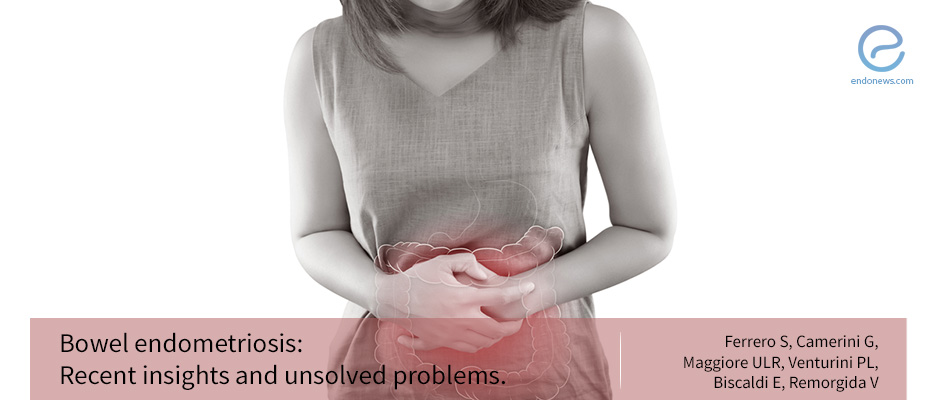Bowel endometriosis: What you need to know
Feb 22, 2019
Recent insights into symptoms, diagnosis and management of bowel endometriosis
Key Points
Highlights:
- As bowel endometriosis symptoms are not specific, all the endometriosis patients with bowel symptoms should be suspected and investigated.
Importance:
- Although the exact prevalence of bowel endometriosis in the general population is unknown, approximately 4-37% of women with endometriosis may have bowel endometriosis.
- Sigmoid colon and rectum are the most commonly affected.
What’s done here?
- A review of recent changes in bowel endometriosis symptoms, diagnosis, and management strategies
Data:
- Up to 37% of women with endometriosis also experience bowel endometriosis.
- Transvaginal ultrasonography and radiological techniques like MRI and multidetector computerized tomography enteroclysis (MDCT-e) are used for accurate diagnosis of bowel endometriosis.
- Hormonal therapies such as progestins may improve the symptoms of bowel endometriosis, however, surgical excision is the best alternative for pain, intestinal symptoms, and fertility.
- Hormonal therapies may not prevent the progression of bowel endometriosis and, therefore, patients receiving long-term hormone treatment should be periodically monitored.
Lay Summary
When the endometrial tissue infiltrates the intestinal walls and reaches inside the intestines, this condition is called "bowel endometriosis". It is estimated that between 3.8% and 37% of women with endometriosis are affected by bowel endometriosis. The endometriosis lesions infiltrating intestines can have different characteristics such as the number and size, how deeply the intestinal wall is infiltrated, and what percentage of the intestines are affected. All of these characteristics contribute to the symptoms observed and treatment strategies adopted.
While smaller lesions are not expected to cause any symptoms, larger lesions may cause constipation, diarrhea, abdominal bloating, painful bowel movements, mucus in stool, or cyclical rectal bleeding. Main reasons for these symptoms are the thickening of the bowel wall by the endometrial nodules and altered bowel physiology. It is difficult to say that abdominal and pelvic pain are specific symptoms of bowel endometriosis because these also occur with pelvic endometriosis, which many of the women with bowel endometriosis also have.
The diagnosis of bowel endometriosis is via ultrasonic and radiological techniques such as transvaginal ultrasonography and MRI. Recently, multidetector computerized tomography enteroclysis (MDCT-e) has also been suggested as a useful diagnostic tool for bowel endometriosis. MDCT-e allows detection of endometriotic lesions in areas of the bowel, which might go undiagnosed by other exams. However, there is one caveat – this technique uses iodinated contrast medium and ionizing radiation, the safety of which are a concern. Rectal endoscopic ultrasonography has been widely used for the diagnosis of intestinal endometriosis; however, this exam is now largely replaced by transvaginal ultrasonography, which is better tolerated by patients and readily available to gynecologists, who are commonly involved in the diagnosis of endometriosis.
Treatment for bowel endometriosis includes hormonal therapy or surgery. Patients with bowel stenosis (thickening of the intestinal wall) and those wishing to conceive are not good candidates for long-term hormone (progestin) therapy, which is known to inhibit ovulation. While hormone therapy can improve the symptoms of bowel endometriosis, it does not prevent the development or progression of bowel endometriosis. Thus, patients using long-term hormonal therapies to treat intestinal endometriosis should still be continually monitored to identify any possible progression of intestinal lesions.
For surgery, it is currently debated whether segmental bowel resection or nodule excision is a better option. Depending on the characteristics of the intestinal lesions (size, number, depth of infiltration, etc.) as well as the surgeon’s experience and preferences, a decision to perform either can be made. Nodulectomy have the advantage of a lower incidence of postoperative unpleasant functional digestive outcomes (such as an increase in the daily number of stools, severe postoperative constipation, and urinary dysfunction), but full recovery of gastrointestinal function is expected after either surgical method.
Research Source: https://www.ncbi.nlm.nih.gov/pubmed/30689680
Bowel endometriosis Diagnosis Endometriosis Intestines segmental resection Nodulectomy Progestin

